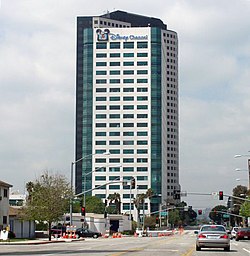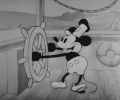Portal:Disney

Introduction


The Walt Disney Company is an American multinational mass media and entertainment conglomerate that is headquartered at the Walt Disney Studios complex in Burbank, California. Disney was founded on October 16, 1923, by brothers Walt Disney and Roy Disney as Disney Brothers Studio; it also operated under the names Walt Disney Studio and Walt Disney Productions before changing its name to the Walt Disney Company in 1986. In 1928, Disney established itself as a leader in the animation industry with the short film Steamboat Willie. The film used synchronized sound to become the first post-produced sound cartoon, and popularized Mickey Mouse, who became Disney's mascot and corporate icon.
After becoming a major success by the early 1940s, Disney diversified into live-action films, television, and theme parks in the 1950s. However, following Walt Disney's death in 1966, the company's profits, especially in the animation division, began to decline. In 1984, Disney's shareholders voted Michael Eisner as CEO, who led a reversal of the company's decline through a combination of international theme park expansion and the highly successful Disney Renaissance period of animation in the 1990s. In 2005, under new CEO Bob Iger, the company continued to expand into a major entertainment conglomerate with the acquisitions of Marvel Studios, Lucasfilm, and 20th Century Studios. In 2020, Bob Chapek became the head of Disney after Iger's retirement. However, Chapek was ousted in 2022 and Iger was reinstated as CEO.
The company is known for its film studio division Walt Disney Studios, which includes Walt Disney Pictures, Walt Disney Animation Studios, Pixar, Marvel Studios, Lucasfilm, 20th Century Studios, 20th Century Animation, and Searchlight Pictures. Disney's other main business units include divisions in television, broadcasting, streaming media, theme park resorts, consumer products, publishing, and international operations. Through these divisions, Disney owns and operates the ABC television network; cable television networks such as Disney Channel, ESPN, Freeform, FX, and National Geographic; publishing, merchandising, music, and theater divisions; direct-to-consumer streaming services such as Disney+, Star+, ESPN+, Hulu, and Hotstar; and Disney Experiences, which includes several theme parks, resort hotels, and cruise lines around the world. (Full article...)
Selected article
Selected image

A headquarters of Disney Channel in Burbank, California.
General images -
Selected biography
Born in Chicago in 1901, Disney developed an early interest in drawing. He took art classes as a boy and got a job as a commercial illustrator at the age of 18. He moved to California in the early 1920s and set up the Disney Brothers Studio with his brother Roy. With Ub Iwerks, he developed the character Mickey Mouse in 1928, his first highly popular success; he also provided the voice for his creation in the early years. As the studio grew, he became more adventurous, introducing synchronized sound, full-color three-strip Technicolor, feature-length cartoons and technical developments in cameras. The results, seen in features such as Snow White and the Seven Dwarfs (1937), Pinocchio, Fantasia (both 1940), Dumbo (1941), and Bambi (1942), furthered the development of animated film. New animated and live-action films followed after World War II, including the critically successful Cinderella (1950) and Mary Poppins (1964), the latter of which received five Academy Awards.
In the 1950s, Disney expanded into the amusement park industry, and in July 1955 he opened Disneyland in Anaheim, California. To fund the project he diversified into television programs, such as Walt Disney's Disneyland and The Mickey Mouse Club. He was also involved in planning the 1959 Moscow Fair, the 1960 Winter Olympics, and the 1964 New York World's Fair. In 1965, he began development of another theme park, Disney World, the heart of which was to be a new type of city, the "Experimental Prototype Community of Tomorrow" (EPCOT). Disney was a heavy smoker throughout his life and died of lung cancer in December 1966 before either the park or the EPCOT project were completed.
Did you know (auto-generated)

- ... that vaccine coverage at schools around the Disneyland Resort was too low for herd immunity when measles broke out in 2014?
- ... that Scarlett Johansson filed a lawsuit against The Walt Disney Company alleging that the release strategy for Black Widow breached her contract?
- ... that, for the Space 220 Restaurant, Disney reached out to NASA engineers to understand what a space elevator might look like?
- ... that some TikTokers make videos about whether to smash or pass Disney characters?
- ... that Encanto's Mirabel is the first Disney heroine to wear glasses?
- ... that John Oliver dared Disney to sue him over his version of Mickey Mouse?
Selected quote
More Did you know...
- ...that the Phineas and Ferb episode "Are You My Mummy?" originally aired as part of "Phineas and Ferb-urary," a special event which showed episodes of the series every night in February 2008 on Disney Channel?
- ...that it took 16 years for the pilot episode of Phineas and Ferb to be picked up?
- ...that Newsies is based on the true story of the Newsboys Strike of 1899 in New York City.
- ...Disneyland cost $17 million dollars to build?
- ...that Walt Disney was an ambulance driver during World War One?
Topics
Recognized content
Subcategories
Related portals
WikiProjects
- Parent projects
- Arts • Amusement Parks • Animation • Entertainment • Film • Television • Visual arts
- Main project
- Disney
- Sub-projects
- Disneyland • Pixar • Walt Disney World
- Related Projects
- Biography • Comics • Fictional characters • Media franchises • Music • Video games
Things you can do

- Requested articles: Walt Disney's Fun-to-Read Library, More...
- Stubs: Work on stubs in articles in Disney stubs.
- Attention: See Category:Disney articles needing attention for any articles which may require attention.
- AfD Discussions: Monitor Disney-related AfD discussions at Wikipedia:WikiProject Deletion sorting/Disney.
- Cleanup: A cleanup listing for this project is available. See also the list by category, the tool's wiki page and the index of WikiProjects.
- Infobox: See Category:Disney articles needing infoboxes for any articles which may require an infobox.
- Article alerts subpage - Monitor article alerts, for more information see Wikipedia:Article alerts
- Tag the talk pages of Disney-related articles with the {{WikiProject Disney}} banner.
- Rate the Unassessed Disney articles, Unknown-importance Disney articles and articles where an assessment has been requested.
- Notability: Articles with notability concerns, listed at WikiProject Notability
Associated Wikimedia
The following Wikimedia Foundation sister projects provide more on this subject:
-
Commons
Free media repository -
Wikibooks
Free textbooks and manuals -
Wikidata
Free knowledge base -
Wikinews
Free-content news -
Wikiquote
Collection of quotations -
Wikisource
Free-content library -
Wikiversity
Free learning tools -
Wikivoyage
Free travel guide -
Wiktionary
Dictionary and thesaurus











































































